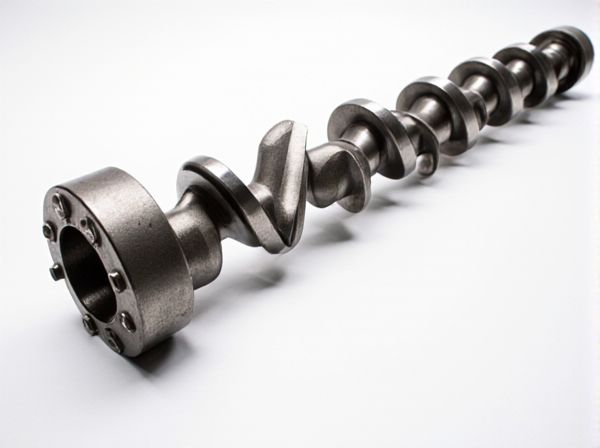
Photo illustration: Forged vs Cast Crankshaft
Forged crankshafts offer superior strength and durability due to the metal being compressed and shaped under high pressure, resulting in a denser grain structure. Cast crankshafts are more cost-effective and suitable for standard engine applications but lack the toughness needed for high-performance or heavy-duty use. Your choice depends on the performance demands and longevity required for your engine.
Table of Comparison
| Feature | Forged Crankshaft | Cast Crankshaft |
|---|---|---|
| Material | High-strength forged steel | Fluid metal casting, typically cast iron |
| Strength | Superior tensile and fatigue strength | Lower strength, prone to micro-porosity |
| Durability | High resistance to wear and cyclic stress | Moderate durability under normal conditions |
| Weight | Typically lighter due to precision forging | Generally heavier due to casting method |
| Cost | More expensive due to complex manufacturing | Cost-effective for mass production |
| Application | High-performance, racing, heavy-duty engines | Standard, low to mid-range engines |
Introduction to Crankshafts
Crankshafts are essential engine components converting linear piston motion into rotational motion, powering the vehicle. Forged crankshafts are made by shaping heated metal using high pressure, resulting in superior strength and durability. Cast crankshafts are produced by pouring molten metal into molds, offering cost-effectiveness but generally lower strength compared to forged types.
What is a Forged Crankshaft?
A forged crankshaft is a high-strength engine component created by shaping heated metal under intense pressure, which aligns the grain structure for enhanced durability and fatigue resistance. This manufacturing process results in superior tensile strength compared to cast crankshafts, making forged crankshafts ideal for high-performance and heavy-duty applications. The precision and toughness of forged crankshafts improve engine reliability and longevity, especially under extreme stress conditions.
What is a Cast Crankshaft?
A cast crankshaft is manufactured by pouring molten metal into a mold, resulting in a solid, integrated structure commonly made from cast iron or cast steel. This process creates a cost-effective component with good wear resistance and adequate strength for standard engine applications. While cast crankshafts are less expensive to produce than forged crankshafts, they typically offer lower tensile strength and fatigue resistance, making them more suitable for moderate performance or everyday vehicles.
Manufacturing Processes Compared
Forged crankshafts are manufactured by shaping heated steel billets under high pressure, resulting in a denser grain structure with superior strength and fatigue resistance. Cast crankshafts are produced by pouring molten metal into molds, allowing complex shapes but often containing internal porosity and lower tensile strength. While forging offers enhanced mechanical properties and durability, casting provides cost-effective mass production with design flexibility.
Strength and Durability Differences
Forged crankshafts exhibit greater strength and durability due to their grain structure being compressed and aligned during the forging process, resulting in enhanced resistance to fatigue and impact stresses. Cast crankshafts, produced by pouring molten metal into molds, generally have a more brittle microstructure with potential porosity, leading to lower fatigue strength and higher susceptibility to cracking under high loads. Automotive and performance applications favor forged crankshafts for their superior tensile strength and reliability in demanding conditions, while cast crankshafts are typically used in standard engines due to cost-effectiveness despite their comparatively lower strength.
Performance Implications
Forged crankshafts exhibit superior strength and fatigue resistance due to the metal grain alignment achieved during the forging process, resulting in enhanced durability under high-stress conditions such as racing or high-performance applications. Cast crankshafts, while more cost-effective and suitable for standard engine loads, typically show lower tensile strength and are more prone to microstructural flaws, which can limit their performance in high-RPM or high-torque environments. The performance implications of choosing forged over cast crankshafts are critical for engine reliability, power output consistency, and long-term wear resistance.
Cost Comparison
Forged crankshafts typically have a higher manufacturing cost due to the use of premium-grade alloy steel and a more labor-intensive forging process, which enhances strength and durability. Cast crankshafts are generally less expensive to produce because casting allows for more complex shapes at a lower material and labor cost but may compromise some mechanical properties. The cost difference between forged and cast crankshafts makes cast options more common in standard production vehicles, while forged crankshafts are preferred in high-performance and racing applications where durability justifies the premium price.
Typical Applications and Use Cases
Forged crankshafts are commonly used in high-performance engines, such as racing cars and heavy-duty trucks, due to their superior strength and resistance to fatigue. Cast crankshafts are typically found in standard passenger vehicles and low- to mid-range industrial machinery where cost efficiency and adequate durability are prioritized. The choice between forged and cast crankshafts depends on the required balance between mechanical performance and manufacturing expenses in automotive and industrial applications.
Maintenance and Lifespan
Forged crankshafts offer superior durability and resistance to wear due to their denser grain structure, resulting in lower maintenance requirements and longer lifespan compared to cast crankshafts. Cast crankshafts, while cost-effective, are more prone to fatigue cracks and require more frequent inspections and maintenance to prevent failure. Regular oil changes and proper engine tuning significantly extend the lifespan of both types, but forged crankshafts generally withstand higher stress and deliver better long-term reliability in high-performance applications.
Choosing the Right Crankshaft
Selecting the right crankshaft depends on the application's performance and durability requirements; forged crankshafts offer superior strength and resistance to fatigue, making them ideal for high-performance and heavy-duty engines. Cast crankshafts, being more cost-effective and suitable for standard engine operations, provide adequate durability for everyday driving conditions. Understanding the operational stresses and budget constraints is crucial in determining whether a forged or cast crankshaft meets the specific mechanical demands.
 caratoz.com
caratoz.com